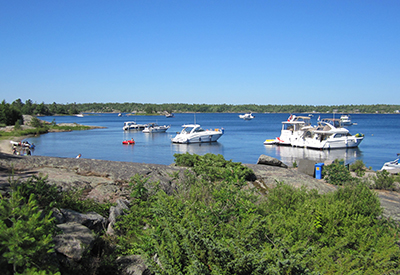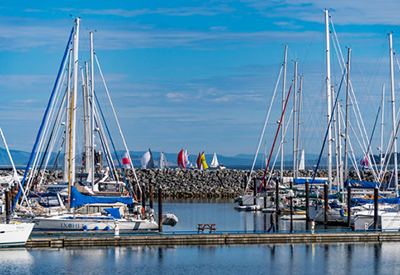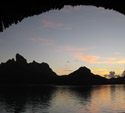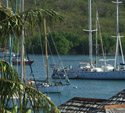The Lady-like Atmosphere of Ladysmith
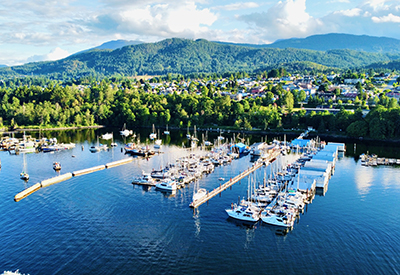
By Marianne Scott
Drone view of Ladysmith Community Marine. Courtesy Ladysmith Community Marina
Instant towns have sprung up in the past, especially on the BC coast. In the late 1850s, Victoria grew overnight into a tent city when hordes of prospectors stopped by to provision for their quest to get rich in the Fraser goldfields. The tents were followed quickly by brick hotels, stores and brothels. Prince Rupert began as a tent town after it was chosen as the Grand Trunk Pacific Railway’s terminus, then built more permanent structures.
But no place went up overnight like Ladysmith, where coal baron James Dunsmuir moved his miners “stock, lock and barrel” after coal seams further north on Vancouver Island had been exhausted.
When I stood on the bluff above Ladysmith Harbour, now home to three marinas, I could imagine Dunsmuir, standing on the same spot in 1898, plotting how he would get his coal shipped out. He’d already privatized large sections of the Stz’uminus First Nation lands for his own profit. Ignoring the Indigenous summer villages that had gathered seafood here for centuries, he took over Transfer Beach, where he washed and loaded his coal.
 James’ father, Robert, left Scotland for Vancouver Island to serve as a Hudson Bay Co. engineer, but after discovering coal near Nanaimo, he formed the Wellington Colliery Company, built the E&N Railway and began shipping his “black gold” from Departure Bay. James was equally ambitious and expanded the company and railway. Once a coal seam was exhausted, he prospected for others.
James’ father, Robert, left Scotland for Vancouver Island to serve as a Hudson Bay Co. engineer, but after discovering coal near Nanaimo, he formed the Wellington Colliery Company, built the E&N Railway and began shipping his “black gold” from Departure Bay. James was equally ambitious and expanded the company and railway. Once a coal seam was exhausted, he prospected for others.
Early days in Ladysmith
By 1904, Dunsmuir had opened his Extension Mines and moved his miners and their houses by train and ox cart to the new site his surveyors had laid out. Looking at a Ladysmith map today shows that Dunsmuir liked organized design, dividing the town into straight-line squares like the cities of New York or Salt Lake. The meandering streets outside the downtown represent modern suburbia.
Hotels were quickly constructed to house the many single miners (one of these, the 122-year-old Temperance Hotel—which served no alcohol—is being totally revamped). Over the next decade, the addition of a post office, schools and churches made Ladysmith an instant company town of about 2,500. From the harbour, sailing ships transported coal thus making themselves obsolete by delivering this fuel to steamships.
Today’s much smaller sailing ships, joined by motorboats, have a choice of three marinas. We chose to stay at the first one, Ladysmith Community Marina. We strolled along the 300-metre visitor dock to the floating clubhouse and visitor interpretive centre with its sweeping rooflines and a combination of natural wood and corrugated metal siding. We were greeted kindly and offered information on Ladysmith where about 8,000 people live today. The building also houses a comfortable seating area, a small restaurant, washrooms, showers and laundry. Outside, a social area with barbeque and picnic tables invites communal food sharing. The Marina’s ample visitor moorage makes it a popular venue for yacht rendezvous.
 The Marina is managed by the non-profit Ladysmith Maritime Society and offers other features beyond a place to tie up. You can take your offspring to a kiosk displaying facts on regional sea life using a touch tank with various critters, accompanied by samples of shells and marine-fauna books. Two heritage vessels are moored next to the Welcome Centre. The 1938 wooden towboat, Saravan, as well the C.A. Kirkegaard participate in community events, festivals and classic boat shows.
The Marina is managed by the non-profit Ladysmith Maritime Society and offers other features beyond a place to tie up. You can take your offspring to a kiosk displaying facts on regional sea life using a touch tank with various critters, accompanied by samples of shells and marine-fauna books. Two heritage vessels are moored next to the Welcome Centre. The 1938 wooden towboat, Saravan, as well the C.A. Kirkegaard participate in community events, festivals and classic boat shows.
Many of Ladysmiths’ old town buildings sport pastel colours
Marina Manager Pat McEvoy told me that the Marina is resurrecting its “Dine on The Dock,” which takes place every other Friday from May through August 2022. The pandemic had shut it down. For a modest price, visiting boaters and residents can taste a dinner prepared by a local chef.
Ladysmith is built on a bluff above what used to be called Oyster Bay—it once had a thriving oyster culture—and it’s a bit of a hike to get into town. It’s a good way to stretch your boat-softened legs to walk up a staircase, then pass a vintage locomotive that once hauled logs. It’s the first of many industrial coal mining and logging artifacts used as public art throughout Ladysmith. To reach downtown, you cross Highway 19 (the Trans-Canada).
As we walked up the hill toward downtown, Roberts Street Pizza, which bakes its wares in a 100+-year house painted canary yellow with vermillion trim. We joined some diners in the side garden richly ornamented with oriental-type decorations, while watching customers arriving in a steady stream to pick up their orders. It was one of the best pizzas ever, loaded with goodies. Proprietor Monroe Myers showed us the house interior completely devoted to preparing pizza, pasta and ribs. “Is the house one of the original miner homes brought here more than a century ago?” I asked him. “That’s always has been a question,” he answered. “Some say yes, some no. But it works for me either way. Business is excellent.”
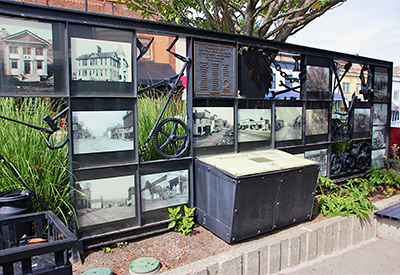 The joys of First Street, one of the main shopping streets with many quaint 100+-year-old buildings, became obvious the next day. Many of the two-story buildings are painted in pastel colours, housing shops ranging from children’s toys to kitchen wares. It’s likely that owners/merchants once lived above their shops. We stopped for breakfast at a Ladysmith institution: the Old Town Bakery. People drive off the Trans-Canada to buy their famous cinnamon buns, scones and pies. We bought coffees and cinnamon buns and ate them on one of the many benches strewn around, while also enjoying people watching.
The joys of First Street, one of the main shopping streets with many quaint 100+-year-old buildings, became obvious the next day. Many of the two-story buildings are painted in pastel colours, housing shops ranging from children’s toys to kitchen wares. It’s likely that owners/merchants once lived above their shops. We stopped for breakfast at a Ladysmith institution: the Old Town Bakery. People drive off the Trans-Canada to buy their famous cinnamon buns, scones and pies. We bought coffees and cinnamon buns and ate them on one of the many benches strewn around, while also enjoying people watching.
Commemorating Ladysmith’s early industry
Strolling along, we noted a clock suspended high above the sidewalk commemorating Knight’s, a former hardware and stationery store. It kept accurate time (not everyone had a reliable clock) and served as a meeting and appointment place. A new, modern public washroom and water fountain are nearby. Then, an elongated metal memorial stretches along the sidewalk: it not only marks the industries that made the town grow, but also shows historical photos of buildings before their streets were paved and sidewalks added.
In the middle of the monument, a plaque lists the names of the 32 miners killed in a 1909 explosion at the Extension Mine (another 16 miners had died in 1901). The funeral corteges lasted two days and touched most families. Dunsmuir’s coal enterprises experienced other troubles. The miners endured dangerous working conditions without profiting beyond their wages. Labour unrest was endemic and unionization forbidden. A violent, bitter strike lasted from 1912-1914.
In the meantime, copper mining and smelting, along with logging, created jobs in Ladysmith. Logging became a mainstay after oil became more important than coal.
The Ladysmith Museum, on First Street, makes its home in an older house. Inside, we learn some fun facts. A vintage wooden highchair can also transform into a stroller; in 1904, Ladysmith got its first telephone exchange and by the end of the year, had 37 subscribers; a pair of boots with nails on their soles taught me how loggers managed to walk on rolly booms; and how miners’ headlamps became much safer after using batteries instead of burning oil.
The Food Scene On the way back to the marina, after eating some traditional bangers-and-mash at the Fox and Hounds Pub, I bought some provisions at Bouma Meats, an excellent butcher that also sells seafood and Cornish pasties. For non-meat eaters, the aptly named Plantitude restaurant offers vegan fare. Appetit Food for Thought built a platform outside its 1901 building during the pandemic where they serve a wide variety of dishes ranging from Peanut Butter French Toast to Thai Hot and Sour Chicken. The Wild Poppy Market serves gluten-free sandwiches and adjoins Old Town Ice Cream (it’s delectable).
I also paused at Post Office Antiques, located on the highway on the way to the marina. It’s housed in a large 1910 brick building, which has abandoned its previous mission to showcase one of the largest collections of collectibles I’ve seen. Three floors are choc-a-block with every kind of antique imaginable.
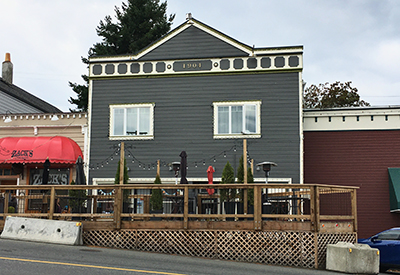 Several hiking trails are available; one can be accessed directly from the marinas. The Marine Walk, part of the TransCanada Trail, leads south to Transfer Beach, or north following an old, abandoned railway path towards the Government Wharf.
Several hiking trails are available; one can be accessed directly from the marinas. The Marine Walk, part of the TransCanada Trail, leads south to Transfer Beach, or north following an old, abandoned railway path towards the Government Wharf.
A typical early 20th century building now home to Appetit Food For Thought Restaurant
Transfer Beach, the place where Dunsmuir loaded his coal, was once full of slag and coal dust, but is now a public park with a charming amphitheatre hosting many musical events. It’s a mere kilometre from the Community Marina.
We found Ladysmith to be an excellent destination. Its compact, walkable size, friendly marinas, plenty of shopping, restaurants and interesting history will bring us back time and time again.
Sidebar
How Ladysmith Got Its Name
Everyone pronounces “Ladysmith” emphasizing the first syllable. But it should be “Lady Smith,” two words with the stress on Smith. In a circuitous way, an actual Lady bestowed her name on this small town.
A British soldier, Harry Smith, came up through the ranks and fought successfully in multiple battles in the early 19th century. In an 1812 skirmish in Spain, he rescued a young woman who was being harassed by British soldiers. Juana Maria de los Dolores de León later became his wife. After many more battles, Harry was promoted to general and was knighted, making him a “Sir” and Juana a “Lady.” The couple followed the battlefields and were stationed in North America (where Harry helped torch Washington D.C.), India and South Africa. Sir Harry became governor of Cape Colony. After the S. African Second Kaffir War (1850), a town was named in honour of Lady Smith, known for her charitable work. Juana died in 1872.
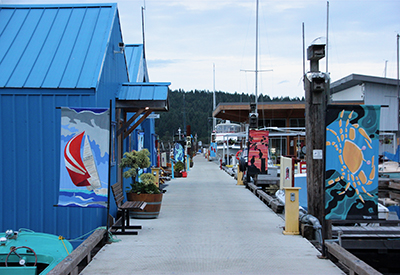 In 1899, during the Boer War, her namesake town was besieged for 11 months. When the British relieved it in March 1900, James Dunsmuir, standing on Oyster Bay, was so delighted hearing about this victory, he named the city he was founding after the South African town of Ladysmith. To learn more about this intrepid couple, Georgette Heyer has made them the central characters in her historic novel, The Spanish Bride.
In 1899, during the Boer War, her namesake town was besieged for 11 months. When the British relieved it in March 1900, James Dunsmuir, standing on Oyster Bay, was so delighted hearing about this victory, he named the city he was founding after the South African town of Ladysmith. To learn more about this intrepid couple, Georgette Heyer has made them the central characters in her historic novel, The Spanish Bride.
The pier at the Ladysmith Community Marina
The Marinas and other info
Ladysmith Community Marina
Full-service marina with 1,000’ of visitor moorage. Reservations recommended.
250-245-1146. VHF 66A. lmsmarina.ca.
Ladysmith Marina
Full-service with moorage for vessels up to 100’. Wi-Fi, 30-50-amps.
250-245-4521. VHF 66A. ladysmithmarina.com/
Ladysmith Fisherman’s Wharf
Focus on fishboats but offers moorage for ± 80 visiting boats. 30-50 amps power.
Office 250-245-7511. Manager Sheryl Bryski, cell 250-618-4720.
tourismladysmith.ca/ for detailed info on hiking trails and 2022 events.


